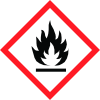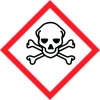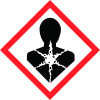(±)-Cucurbic Acid (5mg/mL in Acetonitrile)
TCI EUROPE N.V
Revision date : 2019-01-08




Note: Ingredients listed on restricted chemical lists
General Information
Revision date
2019-01-08
Product name
(±)-Cucurbic Acid (5mg/mL in Acetonitrile)
1.2.1 Relevant identified uses
Reagents
Supplier name
TCI EUROPE N.V
Emergency telephone
+32(0)70 245 245
Icons in SDS
Company Information
Company name
TCI EUROPE N.V
E-mail address of the competent person responsible for the Safety Data Sheet
sales-eu@tcichemicals.com
GHS Information
Signal word
Danger
Hazard Codes
Hazard statements (CLP)
H225, H311, H319, H341, H370, H373
Hazard statements
Code
Statements
H225
Highly Flammable liquid and vapour
H311
Toxic in contact with skin
H319
Causes serious eye irritation
H341
Suspected of causing genetic defects
H370
Causes damage to organs
H373
May causes damage to organs through prolonged or repeated exposure
Precautionary statements
Code
Statements
P210
Keep away from heat, hot surface, sparks, open flames and other ignition sources. - No smoking.
P260
Do not breathe dust/fume/gas/mist/vapors/spray.
P280
Wear protective gloves/protective clothing/eye protection/face protection.
P308+P311
IF exposed or concerned: Call a POISON CENTER/doctor/...
Section 2
2.1 Classification of the substance or mixture
Flammable liquids Category 2 Acute toxicity (Dermal) Category 3 Serious eye damage/eye irritation Category 2 Germ cell mutagenicity Category 2 Specific target organ toxicity - Single exposure [Category 1] Respiratory system, Central nervous system Specific target organ toxicity - Repeated exposure [Category 2] Liver, Blood, Respiratory system, Kidney, Central nervous system
Signal word
Danger
Hazard statements
H225-Highly flammable liquid and vapour. H311-Toxic in contact with skin. H319-Causes serious eye irritation. H341-Suspected of causing genetic defects. H370-Causes damage to organs : Respiratory system Central nervous system H373-May cause damage to organs through prolonged or repeated exposure : Liver Blood Respiratory system Kidney Central nervous system
Precautionary statements
P210-Keep away from heat/sparks/open flames/hot surfaces. - No smoking. P260-Do not breathe mist, vapours or spray. P280-Wear protective gloves, protective clothing, face protection. P302+P352+P312+P361+P364-IF ON SKIN: Wash with plenty of soap and water. Call a POISON CENTER or doctor if you feel unwell. Take off immediately all contaminated clothing and wash it before reuse. P305+P351+P338+P337+P313-IF IN EYES: Rinse cautiously with water for several minutes. Remove contact lenses, if present and easy to do. Continue rinsing. If eye irritation persists: Get medical advice or attention. P308+P311-If exposed or concerned: Call a POISON CENTER or doctor.
PBT Substances
Not applicable
vPvB Substances
Not applicable

